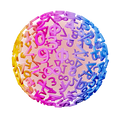Vectors in Three-dimensional Spaces
Vectors in three-dimensional spaces have a lot of applications, from three dimensional figures and animations to navigating a flight from Oslo to New York.
Three-dimensional vectors give you a deeper understanding of how the three-dimensional world works. A new and exciting area of research is 3D-printing, which uses vectors in three dimensions to calculate how to print lots of important stuff, for example human hearts for transplants.
A vector consists of a length and a direction. That means a vector in space has three coordinates that describe its length and direction. Here is an extensive overview of the formulas you learned for two-dimensional vectors, adjusted to work for three-dimensional vectors instead.
Formula
Addition and Subtraction of Three-dimensional Vectors
When you are adding vectors together or subtracting them from each other, you just have to do it separately for each pair of coordinates in the vectors. Remember that if we write the vectors as vectors between points, then .
Example 1
Given the two vectors and , you can find their sum like this:
Example 2
You have two vectors and . The difference between them is
Formula
Multiplication and Factorization of Three-dimensional Vectors
When you are multiplying a number with a vector, all you need to do is to multiply the number with all the coordinates separately. To factorize a vector, you need to find a factor that is shared by all the coordinates of the vector.
Example 3
If , then .
Example 4
You have a vector . A vector pointing in the same direction as can be written as , for which is
Example 5
If and , then is a multiple of , because
Theory
The Position Vector
The position vector is a vector from the origin to the point :
Example 6
If you have a point , its position vector is .
Example 7
You are standing at the point and walk along the vector to . What are the coordinates of ?
In this case, you can see that to find the coordinates of , you can find the position vector and convert it into a point. To find this vector, you first have to convert the point to a position vector, . Then you can find like this:
Theory
Normal Vector
A normal vector to an object is a vector that is perpendicular to the object where they intersect.
A vector that is perpendicular to a line is a normal vector. This is the type of normal you can create with a ruler and a compass in geometry.
Theory
Parallel Vectors
Parallel vectors are vectors that either have the same direction or have opposite directions.
To check whether two vectors are parallel, you need to try writing one of the vectors as a multiple of the other.
Example 8
Are the vectors and parallel?
To figure this out, you have to see whether you can factorize one of the vectors to become a multiple of the other. As has the largest numbers, you factorize that one first. You can see that
which means the vectors are parallel, with .
Example 9
Are the vectors
parallel?
Like in Example 8, you need to see whether you can factorize one of the vectors into a multiple of the other. Now, has the largest numbers, and you can see that
You can’t factorize any of the vectors further, but still none of them are a multiple of the other. That means the vectors aren’t parallel.
Note! You can always extract and change all the signs. You should always try this before concluding that the vectors are non-parallel.
Rule
Length of Vectors
The length of a vector is
Example 10
The length of the vector is
Example 11
Let . Find such that .
You have to express this as an equation:
Because you have squared the equation, you need to be careful and test your answer – in this case, both solutions fit.
Theory
Unit Vector
A unit vector is a vector with a length of . The unit vectors along the -, - and -axes are
Example 12
Find a unit vector along the direction of .
First, you have to find the length of the vector:
Then you have to multiply the vector with 1 divided by its length:






















